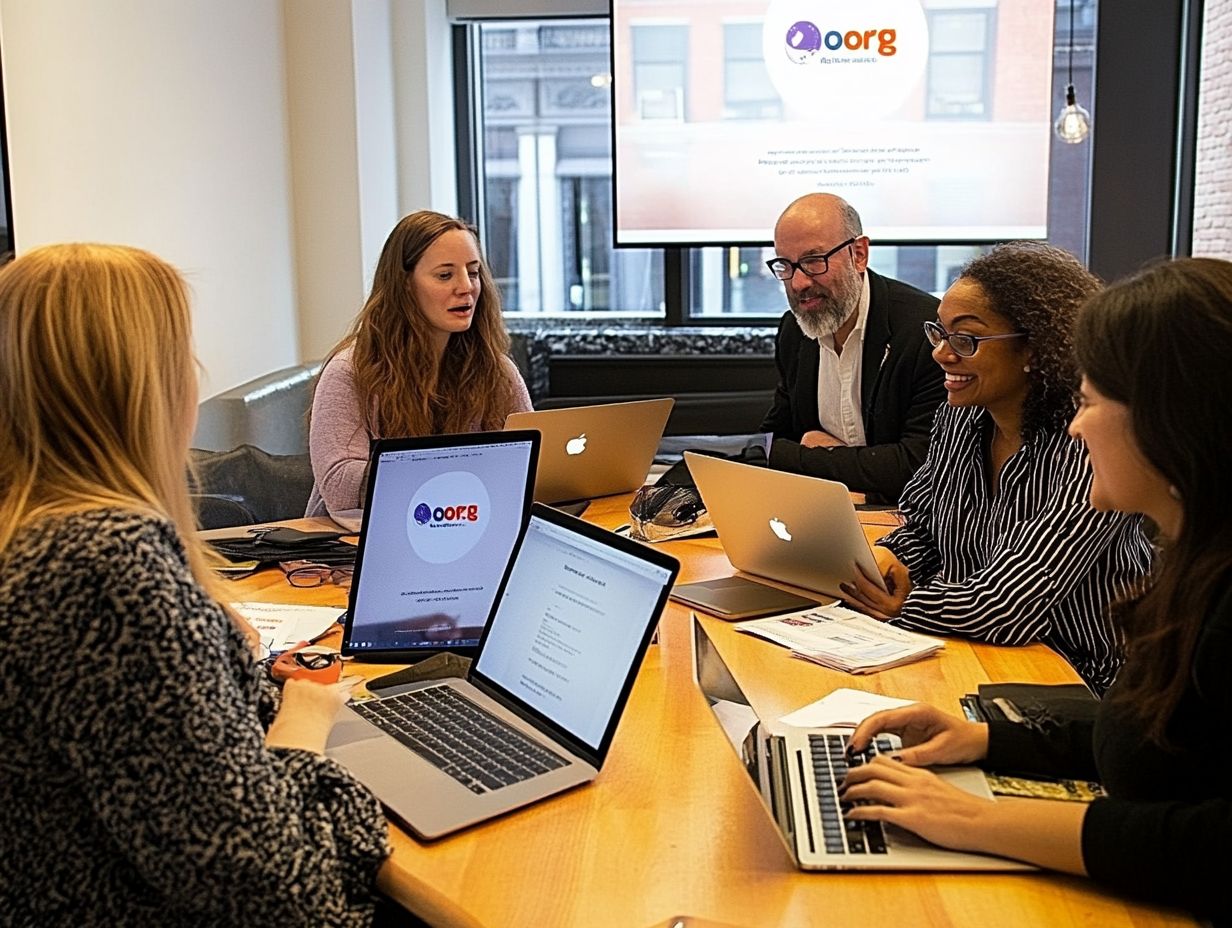In the digital age, selecting the appropriate domain name is essential for any organization, particularly for non-profits. A .org domain name has long been recognized for its credibility and trustworthiness, making it a favored choice among charitable organizations.
This guide examines what a .org domain name entails, along with its advantages and disadvantages, as well as how it compares to other top-level domains (TLDs).
Key factors to consider when choosing a domain and best practices specifically tailored for non-profits will also be addressed. Whether an organization is launching a new initiative or reassessing its online presence, this information will facilitate informed decision-making regarding its digital identity.
Key Takeaways:
- .org domain names are a popular choice for non-profit organizations, providing credibility and aligning with their mission.
- While .org domain names offer benefits such as trust and recognition, they also have potential drawbacks such as competition and lack of availability.
- Non-profit organizations should carefully consider factors such as relevance, availability, and branding when choosing a domain name, and may also want to explore alternative TLDs such as .ngo or .charity.
What is a .org Domain Name?
- 1 What is a .org Domain Name?
- 2 Pros and Cons of Using a .org Domain Name
- 3 Alternatives to .org Domain Names
- 4 Factors to Consider When Choosing a Domain Name
- 5 Best Practices for Non-Profit Organizations
- 6 Frequently Asked Questions
- 6.1 What does the .org in a domain name stand for?
- 6.2 Are .org domain names only available for non-profit organizations?
- 6.3 Why are .org domain names often used by non-profit organizations?
- 6.4 Are .org domain names the best choice for non-profit organizations?
- 6.5 Can for-profit businesses use .org domain names?
- 6.6 Are there any restrictions for registering a .org domain name?
The .org domain name is among the most recognized domain extensions on the internet, primarily utilized by nonprofit organizations, community initiatives, and groups that prioritize public interest.
This domain extension conveys trust and credibility, making it a preferred choice for online platforms focused on promoting social good and engaging with global donors.
In the context of digital marketing, a .org domain name serves as a distinctive identity that reflects an organization’s mission and values, thereby enhancing their online presence and facilitating effective communication with stakeholders.
Explanation of Domain Names and TLDs
Domain names function as the online addresses that facilitate user navigation of the internet, while TLDs, or Top-Level Domains, represent the suffix of the domain name that denotes its type, such as .org for organizations and .com for commercial entities.
These designations are not merely cosmetic; they play a crucial role in shaping a website’s identity and purpose. For example, a .org domain is typically used by non-profit organizations, charities, and community groups, signaling intent and fostering trust among potential visitors.
In contrast, a .com domain is predominantly utilized by businesses aiming to establish a commercial presence online and is often perceived as a more accessible and versatile option.
The choice of TLD directly impacts a website’s credibility and can significantly influence user perception, making it essential for individuals and organizations to thoughtfully consider their objectives when selecting the most appropriate domain extension.
Pros and Cons of Using a .org Domain Name
Utilizing a .org domain name presents both benefits and drawbacks, particularly for nonprofit organizations and social enterprises seeking to establish credibility and trust among their stakeholders.
The .org extension is commonly associated with reputable organizations committed to social good and public interest, which can enhance their reputation within the digital landscape.
However, it is crucial to consider the potential downsides, such as limited recognition for profit-driven businesses, when assessing the advantages of building a strong online identity.
Benefits for Non-Profit Organizations
Nonprofit organizations derive significant advantages from utilizing a .org domain name, which enhances their credibility and trustworthiness in the eyes of global donors and community members.
This domain extension acts as a critical indicator of their commitment to missions focused on social good, rather than profit. When stakeholders encounter a .org address, it often influences their perception, fostering a sense of reliability and connection.
For example, prominent nonprofits such as the World Wildlife Fund and the American Red Cross employ .org domains to not only emphasize their dedication to their causes but also to nurture meaningful relationships within their communities.
This online presence enables these organizations to share impactful stories, showcase their initiatives, and engage supporters effectively, ultimately driving greater awareness and support for their missions.
Potential Drawbacks
While there are significant benefits to utilizing a .org domain name, it is essential for organizations, particularly profit-driven businesses, to consider potential drawbacks that may impact their credibility and reputation.
Many consumers tend to associate .org domains with nonprofit organizations, which can lead to misconceptions regarding a business’s actual status. This misalignment may confuse potential customers who could mistakenly assume that a for-profit entity is funded through charitable donations rather than traditional business revenue.
Consequently, these assumptions may undermine the marketing efforts of such companies, posing challenges in effectively conveying their value proposition. Furthermore, this confusion could deter investors or partners who prefer to engage with clearly defined for-profit entities, highlighting the importance for businesses to meticulously evaluate their domain choices in the context of their overall branding strategy.
Alternatives to .org Domain Names
Exploring alternatives to .org domain names unveils several top-level domains (TLDs), including .com, which is widely recognized and used by businesses, educational institutions, and social enterprises.
This variety of options provides entities with the opportunity to establish a strong digital identity.
Other TLDs and Their Uses
Other top-level domains (TLDs) such as .edu, which is typically reserved for educational institutions, and .net, often utilized by network providers, illustrate the diverse landscape of domain extensions available to organizations.
Plus these, specialized TLDs like .org are widely recognized among non-profit organizations, allowing them to establish credibility and foster trust within their communities. For example, the American Red Cross effectively utilizes the .org extension, reinforcing its commitment to humanitarian efforts.
Newer TLDs such as .tech and .shop cater specifically to the technology sector and e-commerce businesses, respectively, offering distinct branding opportunities. A tech startup may choose the .tech domain to signify innovation, while an online retail store could benefit from .shop to clearly communicate its purpose.
These varied TLDs not only enhance online presence but also assist organizations in targeting their specific audiences more effectively.
Factors to Consider When Choosing a Domain Name
Selecting an appropriate domain name is a crucial decision for any organization, especially for nonprofit organizations.
This choice significantly impacts their online presence, relevance, branding, and overall communication strategy with their audience.
Relevance, Availability, and Branding
Relevance, availability, and branding are critical factors in selecting a domain name, as they significantly contribute to an organization’s online identity and influence how users perceive its mission and values.
Choosing a domain name that aligns with the organization’s goals ensures that the audience can easily connect with its core messages. A relevant name not only reflects the services offered but also enhances the organization’s visibility in search results, ultimately directing potential users to its digital presence.
Domain availability is paramount, as an accessible name bolsters credibility and helps avoid confusion with competitors. This clarity fosters trust among users, who are typically more inclined to engage with a brand that possesses a distinct and memorable domain.
Effective branding through a thoughtfully selected domain name facilitates deeper connections with users, reinforcing the organization’s reputation and promoting loyalty, as it resonates closely with their values and aspirations.
Best Practices for Non-Profit Organizations
Implementing best practices for selecting and utilizing a domain name is essential for nonprofit organizations, as it can greatly improve their online presence and reinforce their connections with stakeholders and the community.
Tips for Choosing and Using a Domain Name
When selecting and utilizing a domain name, nonprofit organizations should consider essential strategies that can optimize their online presence and enhance their marketing development efforts.
A domain name acts as the digital identity of the organization, making it imperative to keep it short, simple, and memorable. A concise name is easier for supporters to recall and share, which is critical for effective word-of-mouth promotion.
The selected name should ideally reflect the organization’s mission, aiding in the communication of its purpose and values from the outset. It is also important to choose suitable Top-Level Domains (TLDs), such as .org, which align with nonprofit values.
By employing effective marketing strategies, organizations can leverage their domain name to bolster outreach efforts, cultivate a stronger brand presence online, and drive engagement across various digital channels.
Frequently Asked Questions
What does the .org in a domain name stand for?
The .org in a domain name stands for “organization”. It was originally intended for nonprofit organizations, but now it is open to anyone to register. This extension is widely recognized on the internet for its association with trusted organizations and the nonprofit community, making it a desirable choice for those aiming to make a positive impact.
Are .org domain names only available for non-profit organizations?
No, .org domain names are open to anyone to register. Originally, it was intended for nonprofit organizations, but now it is used by a variety of websites including businesses and social enterprises. It provides organizations with a sense of trust and credibility on the web.
Why are .org domain names often used by non-profit organizations?
.org domain names are often used by nonprofit organizations because it signifies their charitable or philanthropic purpose. It is also a recognizable and trusted domain extension for these types of organizations, enhancing their online presence and communication with stakeholders, including global donors and families interested in supporting social good initiatives.
Are .org domain names the best choice for non-profit organizations?
While .org domain names are a popular choice for nonprofit organizations, it ultimately depends on the goals and branding of the organization. Other domain extensions, such as .ngo or .charity, may be more suitable for specific causes, like arts and culture or education. Strategic marketing and the organization name play a crucial role in selecting the best domain for an organization’s mission.
Can for-profit businesses use .org domain names?
Yes, for-profit businesses can use .org domain names. However, it may be more beneficial for them to use a domain extension that aligns with their business goals, such as .com or .biz, which are often associated with commercial entities and business development. Considerations such as marketing strategies and online identity should influence the selection process.
Are there any restrictions for registering a .org domain name?
No, there are no restrictions for registering a .org domain name. It is open to anyone to register and there are no specific requirements for eligibility. However, it is recommended for nonprofit organizations to have proper documentation and proof of their nonprofit status to avoid any confusion or disputes. This helps maintain the domain’s reputation for safety and public interest, reflecting its strategic importance to the internet society and domain registrars.














